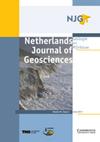Characterising Dutch forests, wetlands and cultivated lands on the basis of phytolith assemblages
IF 2.3
2区 地球科学
Q3 GEOSCIENCES, MULTIDISCIPLINARY
Netherlands Journal of Geosciences-Geologie En Mijnbouw
Pub Date : 2022-09-12
DOI:10.1017/njg.2022.14
引用次数: 1
Abstract
Abstract Palaeoecological reconstructions in the Netherlands are commonly based on pollen and macrofossil analysis, but can be limited if the preservation of organic material is poor. Phytoliths, biogenic silica, do not have this limitation and preserve in settings where other macro- and microfossils do not. Little is known about how phytolith assemblages preserved in soils and sediments reflect the parent vegetation in north-western European systems, so it is currently difficult to contextualise past environments. Here, we characterise phytolith assemblages for soil samples recovered from three major vegetation types in the Netherlands to provide reference data for future reconstructions of past vegetation change. We collected 42 soil surface samples from forests, wetlands and agricultural fields across the Netherlands and characterised the phytolith assemblages they contained. We identified the different phytolith morphotypes and quantified the percentages and concentrations (#phytoliths/cm3 soil) in each sample. We used non-metric multidimensional scaling to assess the variation in phytolith assemblage composition within, and between, the three vegetation types. The phytolith assemblages analysed from the forests, wetlands and agricultural fields were clearly distinguishable from each other. Agricultural fields were dominated by four phytolith morphotypes of grass silica short cells (GSSCs): rondel (tabular), cross type 1 (>15 µm), rondel (elongated) and disturbance or crop phytoliths. Forests settings had significantly higher amounts of different arboreal phytoliths (large and small spheroid rugose) compared with other vegetation types. Wetlands could be identified by significantly higher amounts of Cyperaceae phytoliths (papillate) and other GSSCs (saddle and bilobates with thick castula). Phytolith assemblages could distinguish different subtypes of vegetation within forest and wetland areas, while differences between agricultural systems could not be identified. Our study demonstrates that phytoliths preserved in soils or sediments can be used to separate major vegetation types across the Netherlands. Thus, these results support the hypothesis that phytoliths can be used to infer past environmental conditions in palaeoecological reconstructions. We suggest that future work should: (1) focus on characterising which phytolith types are produced by the commonest tree, wetland, shrub and herb species in the Netherlands and (2) characterise phytolith assemblages across a wider array of vegetation types in north-western European systems to increase the capability for quantitative reconstructions using phytolith assemblages.以植物岩组合为基础,描绘荷兰森林、湿地和耕地的特征
荷兰的古生态重建通常基于花粉和大化石分析,但如果有机物质保存较差,则可能受到限制。植物岩,生物成因的二氧化硅,没有这种限制,并保存在其他宏观和微化石没有的环境中。对于保存在土壤和沉积物中的植物岩组合如何反映欧洲西北部系统的母植物知之甚少,因此目前很难将过去的环境背景化。在这里,我们对荷兰三种主要植被类型土壤样品的植物岩组合进行了表征,为未来重建过去的植被变化提供参考数据。我们从荷兰各地的森林、湿地和农田收集了42个土壤表面样本,并对它们所含的植物岩组合进行了表征。我们鉴定了不同的植物岩形态,并量化了每个样品中的百分比和浓度(#植物岩/cm3土壤)。我们使用非度量多维尺度来评估三种植被类型内部和之间的植物岩组合组成的变化。在森林、湿地和农田中分析的植物岩组合具有明显的差异性。禾草二氧化硅短细胞(grass silica short cells, gssc)的植岩形态主要有四种类型:圆形(rondel)、交叉型(cross type 1)(>15µm)、圆形(rondel)和干扰型或作物型植岩。与其他植被类型相比,森林环境中不同树栖植物岩(大球状和小球状)的数量显著增加。湿地可以通过大量的苏科植物岩(乳头状)和其他gssc(鞍状和双叶状)来识别。植物岩组合可以区分森林和湿地地区不同的植被亚型,而不能区分农业系统之间的差异。我们的研究表明,保存在土壤或沉积物中的植物岩可以用来区分荷兰各地的主要植被类型。因此,这些结果支持了植物岩可以用来推断古生态重建中过去环境条件的假设。我们建议未来的工作应该:(1)重点描述荷兰最常见的树木、湿地、灌木和草本物种产生的植物岩类型;(2)描述欧洲西北部系统中更广泛的植被类型的植物岩组合,以提高利用植物岩组合进行定量重建的能力。
本文章由计算机程序翻译,如有差异,请以英文原文为准。
求助全文
约1分钟内获得全文
求助全文
来源期刊
CiteScore
4.00
自引率
25.90%
发文量
14
审稿时长
>12 weeks
期刊介绍:
Netherlands Journal of Geosciences - Geologie en Mijnbouw is a fully open access journal which publishes papers on all aspects of geoscience, providing they are of international interest and quality. As the official publication of the ''Netherlands Journal of Geosciences'' Foundation the journal publishes new and significant research in geosciences with a regional focus on the Netherlands, the North Sea region and relevant adjacent areas. A wide range of topics within the geosciences are covered in the journal, including "geology, physical geography, geophyics, (geo-)archeology, paleontology, hydro(geo)logy, hydrocarbon exploration, modelling and visualisation."
The journal is a continuation of Geologie and Mijnbouw (published by the Royal Geological and Mining Society of the Netherlands, KNGMG) and Mededelingen Nederlands Instituut voor Toegepaste Geowetenschappen (published by TNO Geological Survey of the Netherlands). The journal is published in full colour.

 求助内容:
求助内容: 应助结果提醒方式:
应助结果提醒方式:


